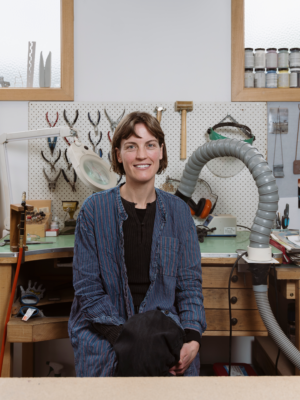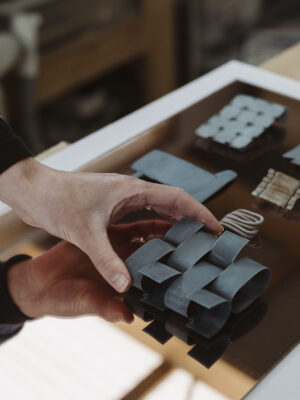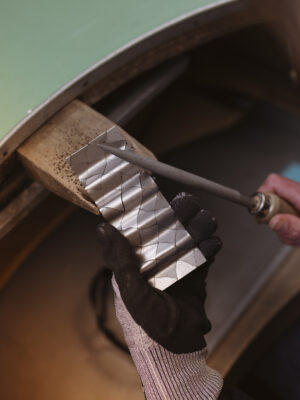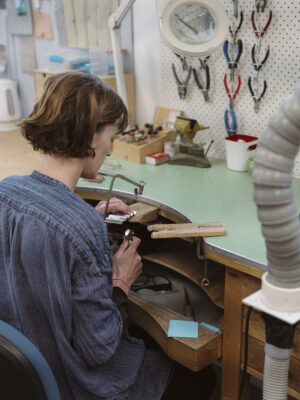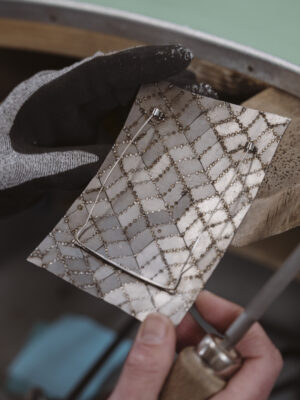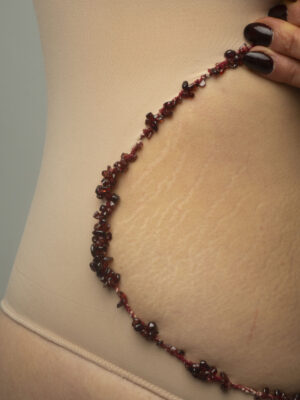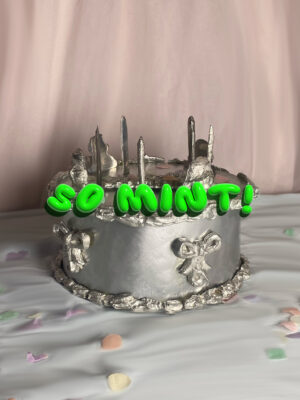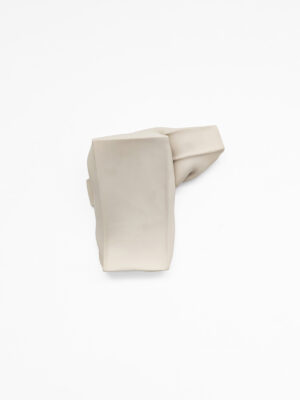Elena Aldrighetti: Your approach to reconsidering everyday items as artistic artefacts seems particularly relevant in an era where overconsumption is a dominant force and people are overwhelmed with ‘stuff’. What kind of beauty do you see in everyday objects?
Aphra Cheesman: I’m very interested in our relationship with our things, which can be quite conflicting for many people, including myself. For those of us fortunate enough to have a lot of things, we can feel overwhelmed by clutter and are also aware of the environmental impacts of material consumption. At the same time, we often want more and can feel very attached to and closely connected with our belongings. Of course, jewellery is a great example of this! We have something called ‘hard rubbish week’ in Melbourne, where people pile up their old furniture, appliances, and everyday objects on the street. It has actually recently stopped in my area but still happens around Melbourne. There are a lot of conflicting feelings about this too. Sometimes, it’s a treasure trove of great finds, while at other times, it’s pretty overwhelming. I collect things from hard rubbish, and it’s where I find some of my materials and inspiration.
Daily life is ever-changing, and there really are limitless things that could be considered ‘everyday objects’. I’m interested in daily life as a social space, and I’m often drawn to objects that show signs of wear and their interactions with people. I see a lot of beauty in the worn and broken; objects that have been used.
Collecting and gleaning are constant parts of my life and creative practice. I often take photos as a way of collecting things I’ve noticed. This allows me to maintain a larger archive that I refer back to when creating work. I find it really important to remain open to chance – I allow things to catch my attention, with one observation leading to another, and so on. There isn’t necessarily a logic or purpose, but it’s interesting how things eventually become relevant or appear in my practice at some point.
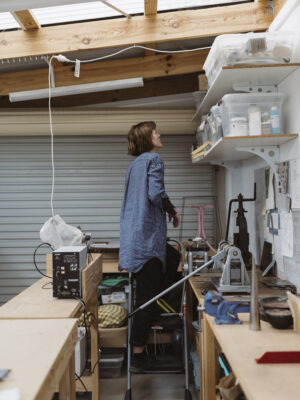

‘I’m interested in daily life as a social space, and I’m often drawn to objects that show signs of wear and their interactions with people. I see a lot of beauty in the worn and broken; objects that have been used.‘


EA: How would you describe your work to someone who has never seen it before? What inspires you, and could you reflect a little on the journey that has brought you to this particular point in your artistic practice?
AC: My work often feels familiar, with subtle references to everyday objects and aspects of daily life. I mostly work in metal to build forms, then add texture and colour using paint and other materials – the colours are muted and domestic. Recently, I’ve been making a lot of brooches, and my work is often displayed in large groups of smaller objects.
I spend a lot of time observing my environment and the objects within it. While out walking, I find interesting things on the ground and in the worn facades of buildings. I collect ideas, forms, objects, and colours – I have a lot of fun finding unexpected connections and humorous associations between things. In the studio, I experiment with materials, colours, form, and texture. My process is playful and not overly focused on the final result, which generates many ideas.
I think there have been many smaller, often serendipitous moments that have brought me to this point in my practice. I have spent a lot of time in the studio, experimenting, making, observing, and collecting, and I’ve had wonderful teachers and mentors along the way. I often think back to early 2020, when I attended a masterclass run by the HANDSHAKE project (NZ) with Iris Eichenberg. During the masterclass, we talked about the ‘less obvious ways to talk about something,’ ‘how to leave questions hovering in the space,’ and ‘the just enoughness of objects.’ The masterclass really changed how I thought about my work. I started to play with levels of familiarity, adjusting forms, adding colour, and changing surfaces. I also began thinking about how objects communicate with each other in groups.
EA: Could you discuss the relationships between ornament, repair, and reuse in your practice?
AC: This question brings to mind a series I made called ‘Holes,’ where I reconstructed the worn patches in everyday objects such as clothing and furniture. As brooches, the objects could attach to the piece of clothing, furniture, or textile and be used to ‘patch up’ the worn areas. In this sense, jewellery can function as a mode of repair. So, I suppose these pieces are simultaneously ornaments, repairers, and enablers of reuse.
I see a lot of beauty in the broken and worn, and my work often seeks to highlight these contact zones between the body and object. My work also frequently references or reuses the worn or broken things I’ve collected. When it becomes jewellery, the material shifts from rubbish to ornament, elevating the perceived value of something that would have otherwise ended up in the bin.
‘I love that jewellery is an artwork that goes out into the world in the most mundane sense – I mean, what other artworks get to go on public transport or to the supermarket?’
EA: Many of the pieces you create possess a very strong material language. How important are intangible qualities, such as sound or functionality, in defining an object for you? How do you perceive materiality through objects or within your practice?
AC: Functionality as jewellery is important to me. I’m interested in how an object sits on the body and how the body can transform an object. I love that jewellery is an artwork that goes out into the world in the most mundane sense – I mean, what other artworks get to go on public transport or to the supermarket?
I think there is also a quality that’s indefinable, perhaps unknowable. For want of a better word, I suppose we could call this an object’s ‘essence’. I see most materials and objects as already having their own history and being imbued with meaning before I work with them. By making, I am adding new meaning – but the original meaning still remains.
It’s really important to me to let the process and materials speak. I often have an idea for a piece, but the idea almost always shifts as I am making it. A material might do something unexpected, or I might make a mistake… I like to embrace these things.
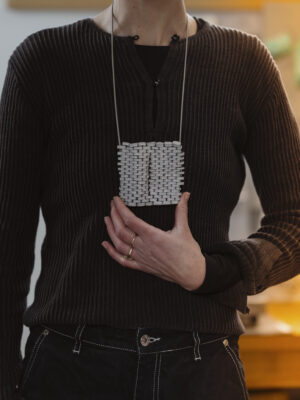
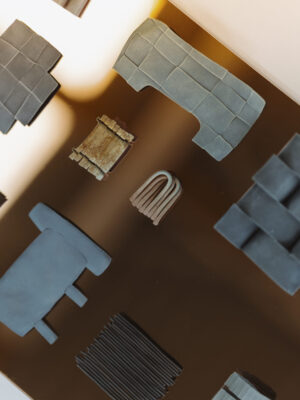
EA: Your practice is primarily based on the careful observation of everyday objects with which you interact. Have you ever considered extending your practice beyond the domestic environment? Is there anything you would like to explore in the future?
AC: I feel like there is so much that could be explored within daily life that it could keep me interested for a long time, perhaps a lifetime. Recently, I’ve been creating work that focuses on more specific aspects of daily life, so this may be my focus for the next few years. I want to continue evolving and adding to my work, though I’m not yet sure how that will look! I’d love to incorporate new materials and experiment with scale. Recently, I’ve been working with materials such as foam and old furniture, and I’ve been making some larger-scale objects for the wall. I plan to dedicate more time to thinking and experimenting in the studio, as I believe that is where new ideas emerge and things can potentially move in different directions.
‘It’s interesting how sometimes you just need a bit of space from your work.’

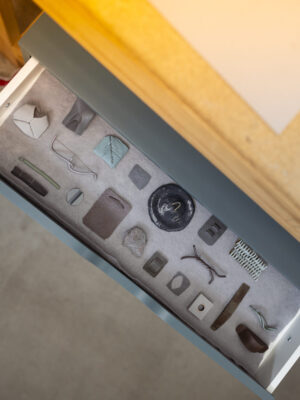
EA: Are you part of Radiant Pavilion? If so, could you share a bit more about your exhibition or the pieces on display, and how you perceive the Melbourne jewellery scene?
AC: Yes, I’m in a couple of group exhibitions. The first is MINUMENTAL at Brunswick Street Gallery. There are 12 of us, and we met through a mentoring programme called HANDSHAKE Project. The second is Here’s Something I’ve Been Wanting To Show You at RMIT Design Hub.
For MINUMENTAL, I’ve searched through old work, samples, and tests. It’s interesting how sometimes you just need a bit of space from your work. The pieces I once rejected as ‘not good enough’… when I look at them again, I can see some other potential. I’ve been adding to, cutting up, repainting, and changing surfaces. I’ve also made a couple of new pieces to add to the group.
For Here’s Something I’ve Been Wanting To Show You, I am displaying some work from my Honours year at RMIT and an earlier piece from 2018 when I had just started to include everyday objects in my practice.
Naarm/Melbourne is an amazing hub of contemporary jewellery activity. There are many proactive makers, advocates for contemporary jewellery, and people who organise exhibitions and community events – it’s lovely to be a part of it! I’ve studied at both RMIT and Melbourne Polytechnic, and a lot of my community is linked to these places. People are very generous with their time, warm, and inclusive. I have a lot of good friends and mentors. Things have been a bit quieter over the past few years, but they are slowly picking up since coming out of COVID. Radiant Pavilion has come at a very good time!
This article was produced by Current Obsession in collaboration with Radiant Pavilion.
Radiant Pavilion is the largest biennial of its kind in the southern hemisphere, highlighting the vital role of contemporary jewellery and object practice in the creative and cultural sector. This year, over 200 makers from Australia and beyond contribute to 60 events across Naarm/Melbourne. The 2024 program explores themes including Indigenous storytelling, climate change, technology, and connection, reflecting the diversity of the artists and materials involved.
All images are the courtesy of Astrid Mulder.
Aphra Cheesman lives and works in Naarm, Melbourne.
She graduated with a BA Fine Art (Honours) from RMIT in 2020. She has exhibited in Australia and internationally and was the recipient of the Talente Gestaltungspreise in 2022. Aphra is represented by Gallery Funaki in Melbourne.
Elena Aldrighetti is an Italian artist and researcher pursuing a Master’s in Craft, Jewellery Art at the University of Gothenburg, Sweden. Her work explores the narrative aspects of making and how senses like taste and smell, along with the memories they evoke, connect with the body and the concept of jewellery.
